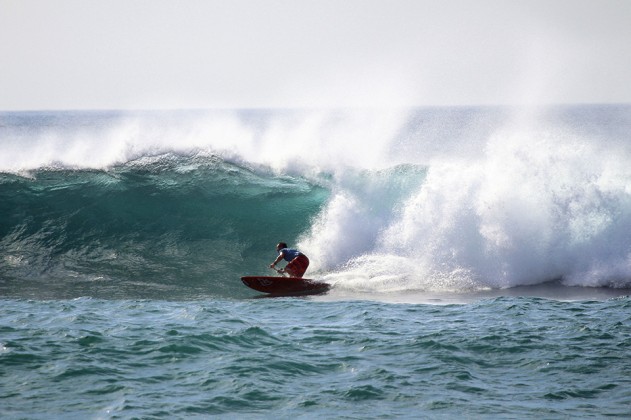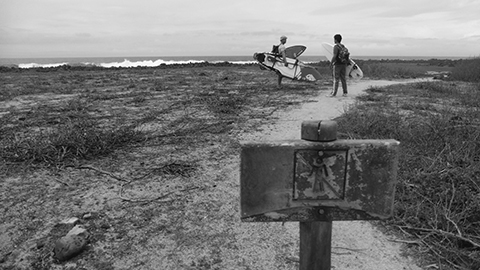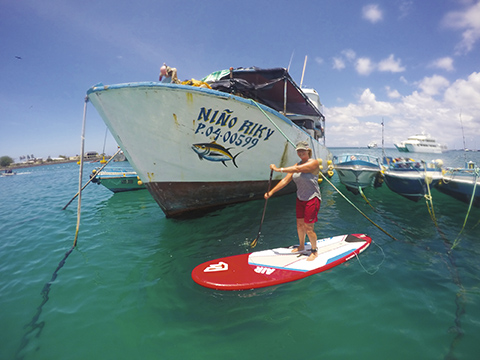STAND UP PADDLE IN THE GALÁPAGOS
I am, quite simply, overwhelmed. Julie and I have paddled from the safety of Shipwreck Bay along the coast to Darwin’s Bay, where the Beagle anchored and Darwin made his first landfall in the Galápagos Islands.
WORDS Rob Small // PHOTOS Rob & Julie Small
I am, quite simply, overwhelmed. Julie and I have paddled from the safety of Shipwreck Bay along the coast to Darwin’s Bay, where the Beagle anchored and Darwin made his first landfall in the Galápagos Islands. Leaving the moored fishing boats behind we joined a riot of local wildlife. The ubiquitous sea lions, yearling pups and their older siblings curious and playful toy with us as we paddle. The patriarch, a 250 kilo bullet of muscle and blubber gives us a warning bark from the small boat he has commandeered for the day before returning to sunning himself. We followed the line of the shore out to the headland, eagle rays engaged in activity what would likely produce more eagle rays, oblivious to our passing as are the pelicans, who give us a quick once over with a reptilian eye before returning to the pressing business of waiting for lunch to swim by. Blue footed boobies drop vertically, their form arrow straight, their prey surely unaware until the end. We detoured by the lighthouse, a landmark at a well known surf spot, getting friendly salutes from a group of surfers waiting for the occasional little wave and made our way down the volcanic coast. The black basalt shoreline, the low cliffs and the lines of the island’s interior are half familiar, reminiscent of the Canary Islands but the dry scrub, verdant Parte Alta and exuberant wildlife are far from our ken, something fantasy like but almost unsettlingly real.
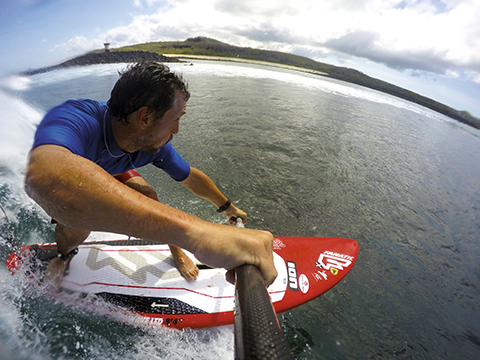
Darwin’s Bay itself sits at the bottom of the Cerro Tirejetas or Frigate Bird Hill above which the frigate birds wheel on the thermals. Julie comments on how they have a touch of the prehistoric about them with their high aspect wings silhouetted against the equatorial sky. It’s a theme that runs through our stay in these latitudes especially as we encounter the island’s animal inhabitants in turn. As the frigates continue their patrol above, we anchor the boards and snorkel in the cool waters of the bay. Again sea lions come and swim with us, curious and graceful in the water. Sea turtles abound as do tropical fish, it is an abundance that is not seen nor present at home and it is endlessly beguiling. Later I climb one of the other low hills overlooking the bay and find the great man himself, his head rather small and his hands and feet curiously large, standing looking towards the south. His famous finches are all about and whilst Julie makes a last circuit of the bay below I ponder on the enormous significance these islands have not only as the unique place they are but also their role in the human species making sense of the hows and whys of existence. Of course these questions overwhelm me as much as the island itself and with the sun well past its zenith I make my way back to Julie and head back for a cold Pilsner, metaphysical discourse generally much improved with a glass or two. Ecuador, perhaps the archetypal Latin American country, has escaped much of the turmoil that some of its neighbours have had to suffer but the Galápagos’ early human history is steeped in blood, blood of pirates, shipwrecked folk and cast aways.
Blood of the famous giant tortoises from which the Spanish name for the islands derives, slaughtered in less enlightened times in their thousands for food and sport. And the blood of early colonists, a mixed bag of chancers, opportunists, dreamers and outright criminals. Thankfully this is all in the past and the Galápagos are now safe, stable and have that relaxed vibe that all the best islands do. Today they have an identity derived from the different regions of the continent, as the Galápaguenos call Ecuador. You can eat ceviche made that way they do it in Manabí, catch highland accents from Quito or hear stories of family members back in Guayaquil. It is all rolled together and the islanders are quick to smile and love to engage, the strangeness of Gringo visitors wearing off a little as tourism develops.
“ I ponder the enormous significance these islands have not only for the unique place they are, but also their role in humans making sense of the hows and whys of existence ”
Our trip coincides with the annual carnival and after a hot day’s paddling we find ourselves in the central plaza watching a boy band from Guayaquil work its way through meringue and rumba numbers, it is early and still a family affair, the plaza packed with local families. We drink beers, eat chicken pinchos from the stalls and chat to mix of tourists and locals. The conversation is easy and I get the low down on the surf. Being bang on the Equator (Ecuador is Spanish for equator) surf comes from the south and in the northern hemisphere winter from the north. There is rumour of a small pulse from the north, Hawaii was good the day before and the word is that it will be here in the morning. As the band winds up and the MC starts geeing the crowd up for the desfile de las reinas, the Carnival Queens parade, we call it a day and head for home, leaving the locals to their beauty contest and dancing.

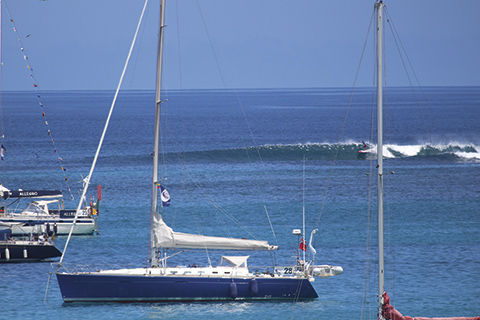
The next morning brings surf but not as big as expected. In fact it is a little wind ruffled and inconsistent. The wind has swung from its normal SE direction and the South Coast is offshore, drawing most of the surfers away. All the waves are rocky reefs but the south swell spots are abrupt, classic island waves coming out of deep oceanic water and impacting on shallow lava shelves. These are challenging SUP waves and with carnival pushing the numbers up I have stuck to my plan and headed out to the north swell spot.
The conditions are fun but definitely not epic and yet I am having one of the surfs of my life. Waiting off the point for the biggest waves, lining up with the lighthouse I can see big reef fish under me, brightly coloured and indifferent to my presence. Off the end of the rocks marine iguanas are diving to feed on seaweed, strangely incongruent yet perfectly suited, completely unique and totally prehistoric in appearance. I am getting waves, any wave I want in fact but enjoying the best lulls I have ever experienced. It seems as if the act of surfing is so much less important than just being there part of all this majesty. A set comes and attempting to get into the first wave I catch movement to my left in my peripheral vision, I am the only one out but still have to give way. A pelican comes from the back of the point, way up the line, surfing the lip line, matching speed with the wave perfectly clearly enjoying the surf as much as I am. The next wave stands up and I ride it all the way to the channel.
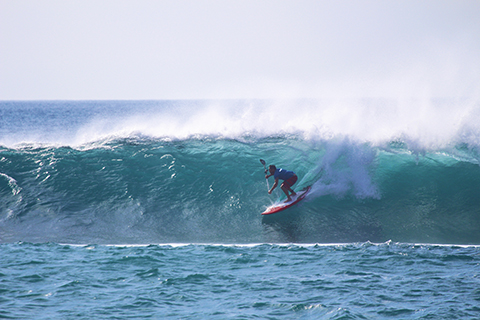
Paddling back to the peak another sea lion plays tag with me whilst a humpback whale breaches out in the deep blue. I cannot quite fathom how special this place is, its magic not diminished at all by time spent here. In these average surf conditions I am experiencing a session that will be remember forever and I am again, overwhelmed. SUP
How to get there
From Quito and Guayaquil several flights a week with Tame, Lan Chile and Avianca. Expect to pay up to $500 round trip. Board bag (max 3 sticks, I took an 8’4” Fanatic pro wave and 2 x surfboards) $50 each way. Don’t forget to get your Galápagos visitor’s card at whichever airport you depart mainland Ecuador from. You will also have to pay a $100pp Park Entrance fee on arrival, actually a pretty good deal.
Where to stay
Plenty of accommodation but if travelling as couple expect to pay $80-$200 a night for a comfortable room with air con. We recommend La Casa Blanca on the seafront. casablancagalapagos.com
When to go
South swell, dry season is March to October, the water and weather are cooler but the waves consistent. North swell, wet season is November to March. warmer, wetter. Inconsistent N swell and smaller S swell, busier in the water.
What to bring
Everything you need in the water, there is almost no supply on the islands. A shorty or vest in the wet season and a light steamer in the dry season, water temps are lower than you may expect due to the Humboldt Current. Boards for flat water and that can handle a bit of powerful reef surf. Reef boots, sunscreen, good leashes. Plenty of extra fins. Ding kit. Sell or gift what you can when you leave, the locals will appreciate it. Surf mags, stickers and T-shirts, caps etc are great icebreakers.
Don’t forget that camera, POV camera, video. You’ll regret not having one if you do! A good attitude. Currently the Galápagos locals are about the friendliest I’ve ever met, anywhere. It’d be a shame if that changed. let’s keep it ‘Chevre!’.
Costs
The Galápagos aren’t a cheap destination. After paying serious $$$ to get there, have somewhere cool to stay you’re still going to need plenty of cash for your day to day stuff, food and beer costs are noticeably higher than on the mainland, think European prices in the touristy places (a vodka tonic will set you back $10). Excursions all have set prices and aren’t cheap but are generally well worth the expenditure – you can’t go into the National Park without a guide so it’s the only way.

